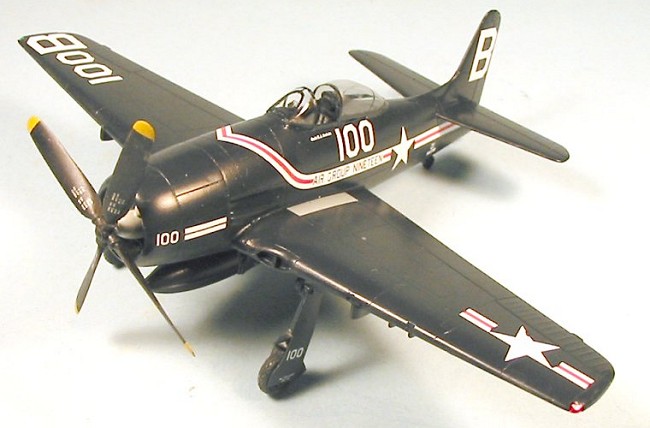
| KIT: | Hobbycraft 1/48 F8F-1 Bearcat |
| KIT #: | ? |
| PRICE: | $18.00 MSRP |
| DECALS: | Two options |
| REVIEWER: | Tom Cleaver |
| NOTES: |

| HISTORY |
If one considers the Grumman F8F-1 Bearcat as a navalized Focke-Wulf Fw-190A-5, you will be tuned in to the underlying design philosophy of what many have termed the ultimate piston-engine carrier fighter.
Grumman Chief Designer Bob Hall, himself no slouch in the cockpit, had been given the privilege of flying a captured Fw-190A-5 in 1943. As was everyone else who ever flew this outstanding airplane, Hall was mightily impressed. He realized that if he could translate all the qualities of the Focke-Wulf to a naval aircraft, he would have created the best fighter in the world - a carrier-based airplane that could take on any other airplane in existence, whether land or sea-based, with confidence of victory.
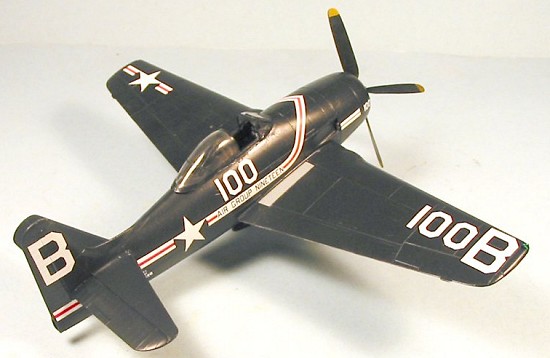 Hall went to Chief Engineer Bob Schwendler and raved about the German
fighter. Both of them realized that creating a minimum-weight,
maximum-performance fleet interceptor would position Grumman to dominate
Navy fighter aviation, since they were already producing the Hellcat, and
were cutting metal on the XF7F-1.
Hall went to Chief Engineer Bob Schwendler and raved about the German
fighter. Both of them realized that creating a minimum-weight,
maximum-performance fleet interceptor would position Grumman to dominate
Navy fighter aviation, since they were already producing the Hellcat, and
were cutting metal on the XF7F-1.
While Hall was proud of the F6F, he had always considered it a compromise. Grumman knew from Navy reports that the new generation of Japanese fighters that would appear in 1944 were already known to be potentially faster than the Hellcat. Not only that, but both Hall and Schwendler personally considered the F4U Corsair to be a superior fighter and knew very well that Chance-Vought was well on the way to overcoming the problems the type was meeting as the Navy attempted to bring it aboard ship. If Grumman was going to keep its place as the Navy’s premier supplier of fighters, that they were going to have to not only beat the enemy, but also the competition.
Hall sat down in the fall of 1943 and began to put his ideas on paper. The result would be the smallest possible airframe combined with the most-powerful and reliable powerplant available. For the first time in fighter evolution, the F6F replacement was smaller and lighter than what preceded it. The XF8F-1 was approximately the size of an F4F Wildcat, with the same powerplant as the larger fighter. The XF8F-1 was not designed as a multi-purpose airplane capable of more than limited use as a fighter-bomber; Hall was quite happy to leave that role to the Hellcats and Corsairs. The XF8F-1 was designed to shoot down other airplanes with rate of climb and roll twice that of the Hellcat. The Bureau of Aeronautics Fighter Desk liked what they saw and the prototype was ordered on November 27, 1943.
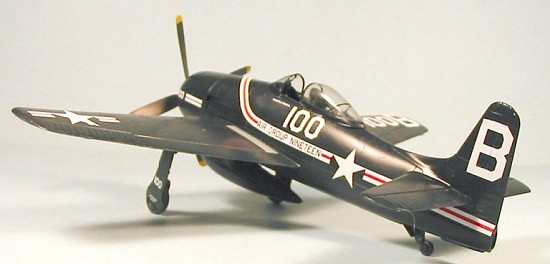 The G-58, as it was known to Grumman also managed to maintain the good
qualities of the Hellcat, particularly its relative docility in coming
aboard a carrier. Using thicker skin and spot welding, the airframe was
significantly cleaner than the F6F. By June 1944, progress on the two
prototypes was such that the Navy - with the experience of the Battle of
the Philippine Sea immediately in mind, ordered 23 additional XF8F01s and
authorized Grumman to take steps to begin production at 100 aircraft per
month. Bob Hall flew the first prototype on August 31, 1944, experiencing
no problems. The second prototype flew in October, and the first production
airplane rolled out of the factory that December. Flight testing revealed
some directional stability problems that were solved with a one-inch
addition to the span of the horizontal stabilizer, and the eventual of a
small dorsal fin.
The G-58, as it was known to Grumman also managed to maintain the good
qualities of the Hellcat, particularly its relative docility in coming
aboard a carrier. Using thicker skin and spot welding, the airframe was
significantly cleaner than the F6F. By June 1944, progress on the two
prototypes was such that the Navy - with the experience of the Battle of
the Philippine Sea immediately in mind, ordered 23 additional XF8F01s and
authorized Grumman to take steps to begin production at 100 aircraft per
month. Bob Hall flew the first prototype on August 31, 1944, experiencing
no problems. The second prototype flew in October, and the first production
airplane rolled out of the factory that December. Flight testing revealed
some directional stability problems that were solved with a one-inch
addition to the span of the horizontal stabilizer, and the eventual of a
small dorsal fin.
TheXF8F-1 made its public debut at the Joint Fighter Conference at NAS Patuxent River in October 1944. The universal response of the pilots allowed to fly it was enthusiasm. As one combat veteran put it, “I’ve finally flown a fighter!” The XF8F-1 received the highest number of votes for “best fighter under 25,000 feet.”
The navy ordered 2,000 F8F-1s, now known as “Bearcats” in January 1945, with Grumman to reach maximum production of 100 per month by July 1945. With the threat of the Kamikaze now known, the entire project took on added urgency. On February 5, 1945, Eastern Aircraft received a contract for 1,800 F3M-1 Bearcats.
VF-19 took delivery of their Bearcats on May 21, 1945, and by July they were deemed ready for combat as they carrier-qualified aboard the escort carrier “Takanis Bay.” On August 2, 1945, the squadron went aboard the USS “Langley” and headed for the Western Pacific and the coming invasion of Kyushu in September. The Japanese surrender on August 15 found the Langley two days outbound from Pearl Harbor, and the Bearcat’s opportunity to prove itself for the job it was designed for was stillborn.
 The end of the war saw the immediate cancellation of the contract with GM
for the F3M-1. Grumman cut back production to 15 per month. Even though
the Navy was now considering jet aircraft, the performance of the Bearcat
was such that it was planned to completely replace all F6Fs in the fleet
squadrons with the F8F as soon as possible, since it had the highest
performance of any Navy fighter (in fact, the Bearcat had a higher
power-to-weight ratio than either the later Panther or Cougar jet
fighters). The writing was on the wall in March 1946 when a BuAer test
pilot in an F8F went up against another test pilot in a P-80B - both were
experienced combat pilots - and found he was unable to take the initiative
at any time against the jet, and was unable to even get in a snap shot.
While theF8F and theF4U-4 would continue to equip Navy squadrons, it was
concluded that the development of jet fighters required maximum priority.
By December 1947, 19 squadrons had F8F-1s and 4 had F8F-1Bs armed with 20mm
cannon. The high point of the Bearcat’s service came in September 1948
when 24 squadrons used these and the F8F-2. The last Bearcats were
delivered in the summer of 1949, by which time the F8F was already being
put to use in second-line duties.
The end of the war saw the immediate cancellation of the contract with GM
for the F3M-1. Grumman cut back production to 15 per month. Even though
the Navy was now considering jet aircraft, the performance of the Bearcat
was such that it was planned to completely replace all F6Fs in the fleet
squadrons with the F8F as soon as possible, since it had the highest
performance of any Navy fighter (in fact, the Bearcat had a higher
power-to-weight ratio than either the later Panther or Cougar jet
fighters). The writing was on the wall in March 1946 when a BuAer test
pilot in an F8F went up against another test pilot in a P-80B - both were
experienced combat pilots - and found he was unable to take the initiative
at any time against the jet, and was unable to even get in a snap shot.
While theF8F and theF4U-4 would continue to equip Navy squadrons, it was
concluded that the development of jet fighters required maximum priority.
By December 1947, 19 squadrons had F8F-1s and 4 had F8F-1Bs armed with 20mm
cannon. The high point of the Bearcat’s service came in September 1948
when 24 squadrons used these and the F8F-2. The last Bearcats were
delivered in the summer of 1949, by which time the F8F was already being
put to use in second-line duties.
Performance of the Bearcat was such that it was the first airplane to be used by the full-time Blue Angels flight demonstration team (the Hellcat-equipped Blues were not a full-time organization). Famed Fleet Air Arm pilot Eric Brown considered the deHavilland Hornet, the Bearcat, and the Hawker Sea Fury to be the finest piston engined fighters he ever flew, in that order. While stationed at NAS Patuxent on detached duty, he remembered being amazed to see Marion Carl make climbing loops on takeoff immediately after retracting his gear in a Bearcat. Pilots I know who have flown the Wildcat, Hellcat, Bearcat and Corsair unanimously consider the Bearcat to be the most exciting of that foursome, as well as the easiest to fly.
| THE KIT |
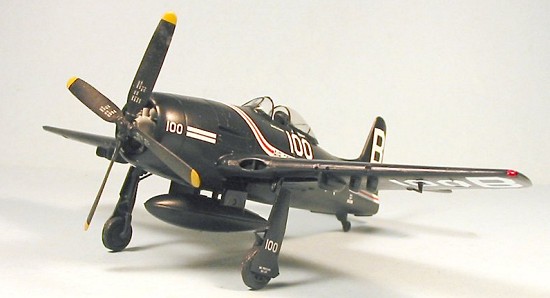 Hobbycraft’s Bearcat was eagerly awaited when it came out in 1998, since
the Hawk/Testor Bearcat released in 1967 was decidedly long-in-tooth. This
was followed by howls of disgust over the mistakes made in the kit, most
prominently the mis-shaped cowling that completely changed the look. Over
the years since, the kit has continued to be released in several different
versions by Hobbycraft, as well as being released by Academy.
Hobbycraft’s Bearcat was eagerly awaited when it came out in 1998, since
the Hawk/Testor Bearcat released in 1967 was decidedly long-in-tooth. This
was followed by howls of disgust over the mistakes made in the kit, most
prominently the mis-shaped cowling that completely changed the look. Over
the years since, the kit has continued to be released in several different
versions by Hobbycraft, as well as being released by Academy.
Several aftermarket suppliers have created correct cowlings and other items for the kit. My model used the sets created by Mike West of Lone Star Models, which include corrected cowling, corrected intake piping, corrected wheel wells, corrected wheels, and a resin cockpit. The Falcon vac canopy originally created for the Hawk/Testor kit is also an item no Bearcat modeler should be without.
| CONSTRUCTION |
What can I say? Construction is extremely straightforward, with only some minor test-fitting of the resin parts necessary, since they were well-designed specifically to fit this kit. I needed Mr. Surfacer on the fuselage centerline and the drop tank.
One problem with the model is that everything is in Glossy Sea Blue, including the interior of the wheel well, which means that all the detail within, which would be difficult to see anyway, is really close to invisible once painted. The cockpit, being overall black other than an interior green floor, presents much the same problem.
| COLORS & MARKINGS |
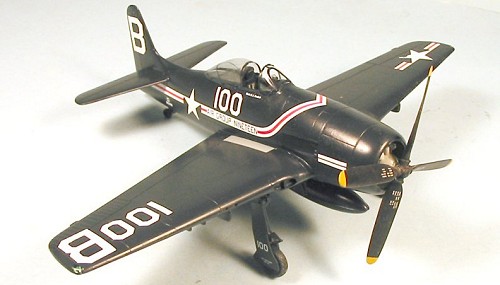 Painting:
Painting:
Painting is so easy it is almost not worth mentioning, since - as said above - everything is Glossy Sea Blue. I used the Xtracrylix Glossy Sea Blue, which is to my eye superior to the too-grey Gunze-Sangyo version, and better than the too-green ModelMaster version. Like Goldilocks’ porridge, the third one is just right - more blue, a hint of green. Applying it thinned 50 percent with the Xtracrylix Thinner gave a smooth eggshell finish.
Decals:
The recently-released SuperScale sheet 48-999 provides the markings for the aircraft flown by the Commander of Air Group 19 in1949, one of the best-known schemes worn by a Bearcat in U.S. Navy service, and one I have long wanted to do. The decals went down easily, and I finished things off with a coat of Xtracrylix Satin Varnish, which provides a sem-gloss finish that is far more appropriate and realistic-looking for a service aircraft than a model finished in high-gloss varnish.
| FINAL CONSTRUCTION |
I attached the prop and the vacuformed canopy, and the model was complete.
| CONCLUSIONS |
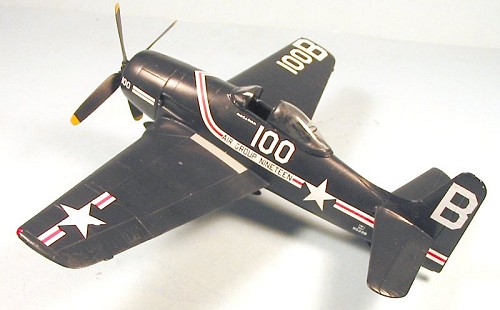 The Bearcat is an interesting looking airplane. It is unfortunate that one
needs to spend more than the cost of the original kit on aftermarket bits
to end up with an accurate-looking model, since not one of these
aftermarket pieces is something that could not as easily have been produced
in the kit with a few hours of research and the choice of better drawings.
Unlike other airplanes, Bearcats are still around in some numbers, so it
would not have been impossible to get the information from the original
source.
The Bearcat is an interesting looking airplane. It is unfortunate that one
needs to spend more than the cost of the original kit on aftermarket bits
to end up with an accurate-looking model, since not one of these
aftermarket pieces is something that could not as easily have been produced
in the kit with a few hours of research and the choice of better drawings.
Unlike other airplanes, Bearcats are still around in some numbers, so it
would not have been impossible to get the information from the original
source.
That said, the kit makes up into a good-looking model of the best performer of Grumman’s piston-engine cats.
May 2005
Kit courtesy of my wallet.
If you would like your product reviewed fairly and quickly by a site that has about 300,000 visitors a month, please contact me or see other details in the Note to Contributors.